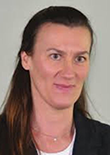|
 VTS continues its long-term commitment to embrace diversity and inclusion (D&I) through various activities and a new dedicated committee within the VTS Board of Governors (BoG) called the IEEE VTS Women and Diversity Committee. These efforts aim to enhance D&I in the engineering community by fostering connections and the visibility of women and other under-represented minorities. VTS continues its long-term commitment to embrace diversity and inclusion (D&I) through various activities and a new dedicated committee within the VTS Board of Governors (BoG) called the IEEE VTS Women and Diversity Committee. These efforts aim to enhance D&I in the engineering community by fostering connections and the visibility of women and other under-represented minorities.
Since late 2000’s, VTS has had representatives within the BoG coordinating activities on diversity, and ensuring VTS’ presence in other IEEE organizations that focus on diversity, such as IEEE Women in Engineering, which has grown to a global organization. VTS President Weihua Zhang and other members of the BoG support projects and activities that focus on diversity and inclusion. They often participate as speakers or panelists in VTS workshops dedicated to diversity and inclusion, at conferences such as VTC and VPPC.
Workshops on diversity at VTS’ flagship conferences have become regular events for professionals from academia/industry and students, and over the years, have been increasingly well-attended by engineers with different backgrounds and at different stages of their careers or studies. Workshops are an excellent opportunity for sharing experiences about challenges faced by minorities, and views on how the engineering world can be more inclusive.
Among our activities in 2023 was a workshop at VTC2023-Spring in Florence, Italy. With its theme, Designing for Diversity, the event’s organizing committee was as follows:
- General Co-chairs Carmela Cozzo (Samsung Research, USA) and Sarah Kate Wilson (Santa Clara University, USA)
- Local Arrangements Chair Ana Garcia Armada (Universidad Carlos III de Madrid (UC3M), Spain)
The hybrid in-person/remote access day included four presentations by keynote speakers and a panel discussion. It was well-attended, spawning interesting discussion during Q&A sessions at the end of the presentations and during the panel. The program is outlined below.
Waveforms and Diversity, Ana Garcia Armada
A review of different waveforms that have been and are being proposed for wireless communications highlights their advantages and weaknesses. Among their characteristics, their capability to leverage diversity was highlighted. And continuing with the subject of diversity, several initiatives to benefit from it (in other dimensions than the pure technical one) were discussed.
The Telecoms Inclusion Opportunity: Design for the Edge, and the Center Comes for Free, Chris Lewis (Lewis Insight, London, UK)
The keynote speech focused on the consideration that, as an industry, we have designed for the so-called mainstream market. This continues to exclude many groups from the benefits of being better connected whether that is on the grounds of age, Disability, affordability, digital skills, language, gender or ethnicity. For the first time, we have an opportunity to consider all of these 'edge' cases and design inclusively to bring these billions of people into the connected world.
Women in Engineering: To Have a Successful Professional Career, Lian Zhao (Toronto Metropolitan University Canada)
The presentation highlighted that D&I is valued in our society, and discussed the benefits of D&I, D&I in Canada and gender diversity. Her career path, as an example of women in engineering, was shared to demonstrate an old-saying: it is never too late to work towards success.
Facts vs. Myths for Women in Engineering, Sarah Kate Wilson
Many programs have been developed to draw girls to engineering. They are great, but they are not enough. Engineering is not attractive to many people due to popular misunderstanding of the field. By addressing some of those myths, the presentation evolved into considerations for how to go forward to make engineering more attractive and more welcoming.
Panel on Designing for Diversity, all keynote presenters listed above, plus Lajos Hanzo (University of Southampton, UK) and James Irvine (University of Strathclyde, UK)
The men, both longtime VTS BoG Members, joined the keynote speakers and workshop co-chairs for a vibrant and insightful discussion. Several aspects of diversity and inclusion were addressed during the panel, and the richness of the different perspectives brought by each of the panelists was truly inspiring and a trigger for follow up thoughts. Here are some of the many aspects discussed during the panel:
- Identity as an important input for designing services and processes so that the end-product can serve well a large community. Identity needs to be maintained in order to address diversity and provide solution for inclusion.
- Diversity in a team brings different perspectives and improves results. The importance of questioning is critical for developing and optimizing solutions.
- Communication tools to be designed with different/special needs that individuals may have. An early consideration of how differently tools would be used ensure a better design that can be used by many. Sometimes, what can be perceived as additional requirements for designing for special needs may even come for free.
- Integrated sensing and communication. The interaction between the individual, the device and the environment is of paramount importance to address different/special needs.
- Overall designing for diversity is a fundamental aspect in the process of enhancing diversity and inclusion in the engineering world and in our society. The designing part would need to become a priority. This topic is broad and can have many implications on designing communication systems.
We all look forward to further discussions, delving into ever-greater detail, at future VTS events on diversity and inclusion! |